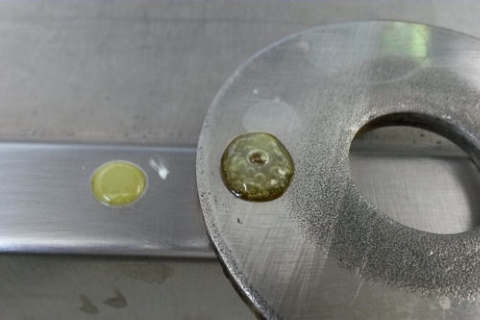How to correctly identify different grades of stainless steel
The term ‘stainless steel’ is commonly used in construction to signify an alloy with good corrosion resistance. But many different grades are available with different alloying elements that provide various properties. Frequently, though, which grade is to be used isn’t made clear within the specification. This can lead to problems if cheaper, inappropriate grades are used when the specifier had intended a more robust grade.
Rupert Pool and the Investigations Team
The grades of stainless steel that are most frequently used in architectural applications are types 430, 304 and 316. These are properly referred to as grades 1.4016, 1.4301 and 1.4401 according to BS EN 10088, but are still commonly referred to by the old SAE numbers above.
When around 17% chromium is added to steel, it becomes ‘stainless’ and has some degree of corrosion protection. This grade is Type 430 and it is widely used for internal architectural components as well as kitchen sinks and washing machine drums. Like ‘normal’ steel, type 430 is ‘ferritic’ and is therefore magnetic.
The addition of around 8-10% nickel greatly improves the corrosion resistance and changes the structure of the alloy to make it ‘austenitic’, which is non-magnetic. The most commonly used grade is type 304, which is used widely in external applications. The famous stainless steel top to the Chrysler Building in New York was constructed from a slightly higher carbon version of 304.
To improve the corrosion resistance even further, the addition of around 2% molybdenum produces a grade that is suitable for particularly severe applications such as coastal installations. This is type 316, which is austenitic and therefore non-magnetic.
Common architectural grades:
- 1.4016 Type 430 17% Cr magnetic, mainly internal use
- 1.4301 Type 304 18% Cr; 8% Ni non-magnetic, general purpose external use
- 1.4401 Type 316 18% Cr; 12% Ni; 2% Mo non-magnetic, coastal use
BRE has seen many architectural specifications that have stated ‘stainless’ with no other distinction. This can be confusing and can lead to incorrect grades being used. In BRE’s experience, most architectural/construction professionals who refer to ‘stainless’ usually mean type 304, as this has good corrosion resistance in external environments and is less costly than 316. But a vague specification should be queried and verified with the specifier in order to ensure that the correct grade is used. It may be necessary to seek advice from the supplier regarding the suitability of the grades to the environment in which it will be installed.

Once stainless steel components have been installed, the easiest way to tell apart the ferritic grades and the austenitic grades is to use a magnet. Distinguishing between 304 and 316, however, is less straightforward and requires a chemical test. This can be done in the laboratory relatively easily or on site using a hand-held XRF analyser – a bit like a Start Trek Tricorder – which will provide the chemical composition of the alloy. An alternative (and cheaper) method is the Avesta Moly Drop Test. This is an acidic solution that contains an indicator, which reacts with molybdenum. One drop, applied to a freshly abraded surface, will show in a few seconds whether the stainless steel contains molybdenum or not.
